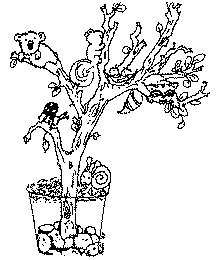BACKGROUND:
Science in kindergarten
is all about observing the world by using a child’s senses. In later
grades children will use some of the experiences they experienced in the
lower grades. A child’s experience is not only talking and observing
different objects, but also touching and playing with equipment.
Play is an integral part in a child’s discovery of science and math.
Observation is a very important
concept in science and is usually overlooked when teaching basic skills.
Observing your surroundings and mentally recording this information is
very important because it is from observation that many decisions are made.
The better the observational skills of a child, the more they can learn
on their own. Children, however, must have a baseline to start developing
their skills. Observation is not an inborn skill, it is a learned
behavior. This exercise helps teach students to think critically
while they are observing objects in nature.
PROCEDURE:
- Prior to this
activity, ask your students if they have old nests they have found.
Remember, make sure they do not take nests that are occupied.

- You can make a display that
will become a colorful addition to your classroom and a future home for
all the nests you find throughout the year. It just takes a large
branch (about 2 meter tall) with smaller branches able to support nests.
Ask a neighbor or parent to save a large branch when they trim a tree.
Make sure you "cure" the branch
first, leaving it outside so the sap and "bugs" leave the branch before
you bring it into the classroom. Get a base (redwood tub is ideal)
and wedge the branch into the base of the tub. Put large rocks in
the tub to make sure the branch will not move.
We suggest that you put the
"tree" together in the classroom because the rocks will make it too heavy
to easily move. Use artificial grass or turf at the base of the "tree"
and artificial leaves and flowers on the branch to make your "tree" look
realistic.
- Introduce information
on birds and how they build nests. Try to use information provided
by children to gain information for the rest of the class. Ask questions
like, “Where do you find nests?” “Who has found nests before and
where were they found?” “Do most birds build nests?” “What
do birds use to make their home?”
- Show any real or models
of nests you might have to students. Discuss what type of egg
might fit into the nest. Small nests can only hold small eggs and
large nests can only hold large eggs. Small eggs come from small birds,
and large eggs come from large birds. Just by looking at the nest,
you can tell how large the bird is!
- The worksheet focuses
on a child discovering a nest. Have the students become the child
in the picture and is describing their discovery to someone else.
How large is the egg, how large would the mother bird be, and what is the
nest made of? Make sure the children color each egg the same color.
Although there are many different colors of eggs, the eggs from one bird
are the same color. This is an excellent time to warn students not to disturb
the birds. Birds are organisms like us and deserve respect.
|